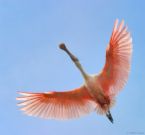
Find a printable copy of the Bird Brochure here!
Take a ride along Surfside Beach’s Bluewater Hwy and Intracoastal shoreline and spot one of these stunning roseate spoonbills. Surfside Beach's Intracoastal shoreline is the southern boundary of the Brazoria National Wildlife Refuge and provides critical bird habitat on the Texas Gulf Coast.
The ecological diversity of Surfside, (marsh, coast, marine, bay, scattered woodland and natural parks), combined with relatively mild climate, make Surfside an ideal home and sanctuary to over 300 resident and migratory bird species. Located on Central Flyway, Surfside is particularly important as a stopover for both Trans-Gulf and Circum-Gulf migrants. On a “wave” day it’s possible to say over a hundred migrant species with over 30 warblers alone!
Out of migration season Surfside Beach is still a birder’s paradise. Northern gannets and fulmars may be seen in the winter from the jetties and mergansers drift into the calm waters to feed. Wintering raptors can be seen along the beach and marshes and large numbers of wildfowl spill over from Brazoria NWR into the small pools and marshes. Throughout the year Brown pelicans, gulls, terns, herons, egrets, stilts, shorebirds and even the much sought-after Magnificent Frigatebird, congregate along Bluewater Highway. Coastal and marine viewing opportunities abound in Surfside Beach and include Christmas Bay, Surfside Jetty Park, Surfside Crabbing Pier, Stahlman Park and the jetty amongst many others.
After you have completed your driving or walking tour of the marshes and shoreline venture into the Surfside marsh area for elusive rails and coastal sparrows or the recently developed Bird and Butterfly Trail to watch numerous migrating and resident birds in their natural habitat.
The Surfside Bird & Butterfly Trail is 2.5 miles surrounded by native plants and trees and is bordered by the Freeport Harbor. Opened in March 2019, this is a great place to spot butterflies, Orioles, Buntings, Tanagers, Warblers and more. The entrance is located at the corner of Parkview and Monument Drive near Surfside Beach City Hall.
Surfside provides a unique birding experience any time of year. Spring and Fall provide great opportunities to see migrating passerines as they pass through Texas on their way North and South. In Winter it becomes a haven for raptors and wildfowl and in Summer provides critical habitat for nesting plovers, oystercatchers and many others.
Birders will delight in the sheer range of habitat and sheer number of species. There is never a dull moment! Make sure to bring your binoculars and camera!
Surfside Parks and Recreation Master Plan
As the first landfall along the Gulf, record numbers of birds are sighted in Brazoria County each year. Recognizing the importance of our location to migrating bird populations, and being on the Great Texas Coastal Birding Trail, the Village of Surfside Beach beautification/tourism committee developed a Park Master Plan, adopted in 2010, that focused on nature tourism. The plan included the creation of 5-miles of walking/biking trails and several parks, with an emphasis on habitat conservation. Nine years into the 20-year plan, much of the plan has been implemented, culminating with the opening of Surfside Bird and Butterfly Nature Trail in March 2019. The Surfside Bird and Butterfly Trail provides a dedicated area to observe and record migrating and resident bird and butterfly populations focused on enhancing pollinator and upper coast woodlands bird and butterfly habitat.
With support from Keep Surfside Beach Beautiful, the Gulf Coast Bird Observatory, Brazoria County Master Gardeners and many more monthly nature and conservation talks; local awareness of wintering waterfowl and migratory songbird habitat are promoted, encouraging residents to plant native trees and pollinators providing critical food for migrating birds throughout the community. With the success of the nature trail, elevated walkways and observation decks along wetland habitats are the next project to come!
How you can help our birds!|
Birds must have food sources that are nutritious and readily available. Please consider planting only native plants that are suitable to this area so that birds and other wildlife. Bringing nature to your yard begins from the ground up! Plant natives and the birds will come!
National Audubon Society’s Plants for Birds program will provide you with a link by zip code of native plants and what birds will be attracted to the specific plants ·
Tips for landscaping for birds
- Less maintenance for property owners
- Natural source of food, shelter and nesting sites
- Native plants provide food at the correct time for migrating birds
- Remove invasive plants that are of no value to wildlife and actually take over desirable habitat
- See this link for invasive plant species in our area. o
https://www.texasinvasives.org/i101/ecoalert_detail.php?ecoregion_id=2
Providing food and water for birds and discern the benefits of natural food sources from supplemental feeding.
According to the TPWD website: “The best way to provide food for birds is to plant native plants, but bird feeders can also be an important tool. Bird feeders attract birds and often provide enjoyable viewing experiences. There are many different types of feeders and food to choose from, so it is important to consider which types of birds are present in your area so you can target the species you want to attract. “ ·
https://tpwd.texas.gov/wildlife/birding/bird-city-texas/resources/habitat-resources/#providing-food--water----shelter
Local educational resources
- GCBO – Gulf Coast Bird Observatory
- Brazoria National Wildlife Refuge
- Quintana Neo-Tropical Bird Sanctuary
- Cradle of Texas Master Naturalists
- Brazoria County Master Gardener Association
- Brazoria County Extension Service
Birding events
- WMBD – World Migratory Bird Day
- Nature Fest
Bird-related citizen science projects
Bird Club - TBA
Threats to Birds and How You Can Help
There are so many threats and natural issues affecting our birds but there are many ways you can reduce those threats and keep our birds safe.